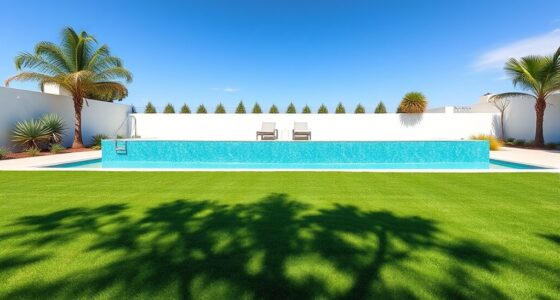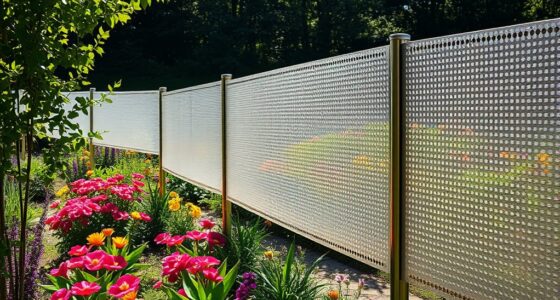Vanishing-edge pools create a sleek, modern look by making water appear to flow over the edge into a hidden basin, perfect for a stunning horizon view. Perimeter-overflow pools have water spilling evenly along the entire edge into a gutter system, offering a continuous flow that’s visually striking but easier to maintain. The main differences lie in their design, installation, and upkeep. To understand which suits your space and lifestyle best, explore the detailed aspects further.
Key Takeaways
- Vanishing-edge pools create an infinity illusion with water flowing over one or more edges, blending seamlessly with the horizon.
- Perimeter-overflow pools feature water spilling evenly over the entire edge into a hidden gutter system, emphasizing continuous flow.
- Vanishing-edge pools require reinforced structures and precise placement of catch basins, typically involving higher initial costs.
- Perimeter-overflow pools are generally more cost-effective, easier to maintain, and suitable for managing larger water volumes.
- Choice depends on aesthetic preference, maintenance willingness, and environmental factors like wind or debris.
Defining Vanishing-Edge and Perimeter-Overflow Pools

When choosing between vanishing-edge and perimeter-overflow pools, understanding their fundamental designs is essential. Vanishing-edge pools feature a sleek, infinity-edge look, where water flows over one or more edges into a catch basin below. This creates the illusion that the pool seamlessly merges with the horizon or surrounding landscape. Perimeter-overflow pools, on the other hand, have water flowing evenly over the entire perimeter, often into a hidden gutter system. This design provides a uniform overflow, giving a clean, modern appearance. Both types rely on gravity to move water, but they differ in how water spills and is collected. Recognizing these core differences helps you determine which style best suits your aesthetic and functional preferences. Additionally, the materials used in construction, such as waterproofing techniques, play a crucial role in maintaining the integrity and appearance of each type.
Visual Impact and Aesthetic Appeal

The visual impact of a pool considerably influences its overall appeal, and both vanishing-edge and perimeter-overflow designs offer striking aesthetic qualities. With a vanishing-edge pool, you create the illusion that the water seamlessly merges with the horizon or surrounding landscape, delivering a sleek, modern look. It emphasizes clean lines and a sense of infinity, making your space feel more expansive and luxurious. On the other hand, perimeter-overflow pools showcase water spilling over the edges in a controlled, continuous flow, adding a dynamic, elegant touch. This design highlights the water’s movement, creating a tranquil yet sophisticated atmosphere. Both styles elevate your outdoor space, but your choice depends on whether you prefer a minimalist, infinity effect or a more pronounced, flowing water feature. Incorporating aesthetic appeal elements like lighting and landscaping can further enhance the overall visual impact of either pool type.
Water Circulation and Filtration Systems

Both vanishing-edge and perimeter-overflow pools rely on efficient water circulation and filtration systems to maintain their stunning appearance and hygiene. These systems ensure clean, clear water by constantly removing debris and balancing chemicals. In vanishing-edge pools, water flows over the edge, requiring precise pumps to maintain a steady flow. Perimeter-overflow pools use a hidden trough to catch excess water, needing robust filtration to handle higher water turnover. To help you understand their differences, here’s a quick comparison: water circulation and filtration systems are critical for maintaining the pool’s aesthetic and health.
Installation Process and Structural Considerations

Installing vanishing-edge and perimeter-overflow pools involves careful planning of their structural foundations to guarantee stability and water integrity. You need to start by assessing the site’s soil conditions and ensuring the ground can support the pool’s weight. For vanishing-edge pools, a reinforced concrete shell is essential to withstand water pressure and prevent leaks. Perimeter-overflow pools require a robust overflow edge, often made of concrete or masonry, designed to handle continuous water flow. Precise placement of the catch basin or trough is crucial to manage water overflow effectively. During installation, ensure that the pool’s level is perfectly aligned, as even minor deviations can impact water flow and visual appeal. Proper structural considerations ensure long-term durability and a seamless, functional pool. Additionally, understanding the contrast ratio and its effect on water appearance can help optimize the visual impact of the pool’s design.
Maintenance Requirements and Challenges

You’ll need to regularly clean and remove debris from both systems to keep them functioning properly. Over time, buildup can clog the overflow or affect the vanishing edge’s water flow. Additionally, maintaining the structural integrity is essential to prevent leaks or damage that could compromise safety and aesthetics. Implementing proper maintenance practices can help mitigate issues caused by environmental factors such as climate change impacts on water features.
Cleaning and Debris Removal
Maintaining a vanishing-edge or perimeter-overflow pool requires regular cleaning to guarantee the water stays clear and the system functions properly. Debris like leaves, dirt, and insects can quickly cloud the water and clog the overflow channels if not removed frequently. To keep your pool pristine, you’ll need to:
- Skim the surface daily to catch floating debris before it sinks.
- Vacuum the bottom regularly to remove dirt and algae buildup.
- Clean the overflow troughs and skimmer baskets to prevent blockages.
Consistency is key; neglecting debris removal can lead to water quality issues and strain the filtration system. Using the right tools and establishing a routine will help you maintain clarity and ensure your pool’s edge remains stunning and functional.
Structural Integrity Concerns
Because vanishing-edge and perimeter-overflow pools rely on precise structural elements to create their seamless appearance, their integrity demands ongoing attention. You need to regularly inspect the water levels, as fluctuations can stress the edge materials. Cracks or shifts in the coping or surrounding structure can compromise the pool’s stability and leak prevention. Maintaining proper water balance is essential to prevent stress on the vessel and prevent damage. You should also monitor for erosion or settling in the foundation, especially in areas with shifting soil. Consistent maintenance ensures the structural components stay aligned and secure. Regularly reviewing local building codes and permits can help ensure your pool remains compliant with safety standards. Neglecting these aspects could lead to costly repairs or even dangerous failures. Staying proactive with inspections and repairs helps preserve both the beauty and safety of your pool.
Cost Differences and Budget Planning

When comparing installation expenses, vanishing-edge pools often require more initial investment due to complex setup needs. Long-term maintenance costs can vary considerably between the two, impacting your overall budget over time. Planning for potential upgrades is essential to guarantee your choice remains financially feasible down the line. Recognizing recurring number patterns can help anticipate ongoing costs and maintenance needs more effectively.
Installation Expenses Comparison
Are you wondering how the installation costs of vanishing-edge pools compare to perimeter-overflow systems? Generally, vanishing-edge pools tend to be more expensive upfront due to their complex design and specialized materials. Perimeter-overflow systems usually cost less to install but may require additional features for a seamless look. When budgeting, consider these factors:
- Vanishing-edge pools often need custom concrete work and precise leveling
- Perimeter-overflow setups may involve simpler construction but higher water treatment costs
- Additional equipment, like pumps and filtration, can vary considerably between the two
Your choice impacts initial expenses more than ongoing costs. Planning carefully now ensures your budget aligns with your vision, avoiding surprises later. Both options can fit different budgets with proper planning, but vanishing-edges generally demand a higher initial investment.
Long-term Maintenance Costs
While vanishing-edge pools often require higher initial installation costs, their long-term maintenance expenses tend to be similar to or slightly higher than perimeter-overflow systems. You’ll need to regularly clean the weir or catch basin to prevent debris buildup, which can be more challenging due to the design. Additionally, maintaining the water level is vital to guarantee proper overflow and prevent damage; this may involve more frequent water top-offs or auto-fill systems. The exposed edges can also be more prone to wear and tear, requiring periodic repairs or sealing. Pumps and filtration systems in vanishing-edge pools might need more frequent servicing due to increased evaporation and splash-out. Overall, while maintenance costs are comparable, expect slightly higher ongoing expenses with vanishing-edge pools. Incorporating easy-to-maintain materials can help reduce some of these ongoing costs and simplify upkeep.
Budgeting for Upgrades
Budgeting for upgrades on vanishing-edge pools requires careful planning, as their initial costs can be higher than perimeter-overflow systems. You’ll need to account for specialized equipment, higher-quality materials, and professional installation. These factors can significantly impact your budget. To manage costs effectively, consider:
- Setting aside a contingency fund for unexpected expenses
- Comparing quotes from different contractors to find the best value
- Prioritizing upgrades based on your usage and long-term benefits
While vanishing-edge pools offer stunning visuals, their maintenance and upgrade costs can add up. Planning ahead helps you avoid surprises and ensures your investment aligns with your budget. Being strategic now makes future upgrades smoother and more affordable. Additionally, practicing mindfulness and presence can help you stay focused during the planning process, reducing stress and making decision-making more effective.
Ideal Settings and Lifestyle Compatibility

Choosing between a vanishing-edge and a perimeter-overflow pool depends heavily on your lifestyle and the setting you prefer. If you love a sleek, modern look and enjoy entertaining guests, a vanishing-edge pool offers a stunning visual that blends seamlessly with the surroundings. It works well if you’re comfortable with regular maintenance to keep water levels consistent. On the other hand, if you prefer a more functional design that manages large water volumes effortlessly, a perimeter-overflow pool suits active households or those in windy areas. It provides easier water level control and better filtration. Think about how much time you’re willing to dedicate to upkeep and the aesthetic vibe you want to create—your choice should complement your daily routine and the overall landscape. Additionally, consider how your choice aligns with outdoor design trends and the safety features needed for your family.
Frequently Asked Questions
How Do Vanishing-Edge Pools Handle Heavy Rainfall or Runoff?
You don’t need to worry about heavy rainfall or runoff with vanishing-edge pools because they typically have a hidden catch basin or drainage system that manages excess water. When it rains heavily, the overflow is directed into the pool’s drainage system, preventing flooding or water spilling over the edge. Regular maintenance guarantees these systems work efficiently, allowing you to enjoy your pool even during storms without concern.
Are Perimeter-Overflow Pools More Energy-Efficient Than Vanishing-Edge Pools?
Perimeter-overflow pools tend to be more energy-efficient than vanishing-edge pools because they use simpler filtration systems and require less water movement. Studies show they can save up to 20% on energy costs annually due to reduced pump workload. You’ll likely notice lower electricity bills and less strain on your pool’s equipment, making perimeter-overflow pools a smart choice if energy savings are a priority for you.
What Safety Features Are Recommended for Each Pool Type?
You should install safety features like secure fencing, self-closing gates, and pool covers for both pool types. For vanishing-edge pools, consider installing alarms on access doors, as they often have open sides, to prevent accidental falls. Perimeter-overflow pools benefit from anti-slip surfaces around the deck and clear signage. Always guarantee proper supervision and regular maintenance of safety equipment to reduce risks and keep everyone safe.
Can These Pools Be Customized for Unique Landscape Designs?
Imagine your pool as a canvas waiting for your personal masterpiece. Yes, you can customize both vanishing-edge and perimeter-overflow pools to match your landscape’s unique features. You might incorporate natural stone, lush greenery, or curved contours, blending the pool seamlessly into your yard. With thoughtful design, your pool becomes a reflection of your style, turning a simple water feature into an extraordinary landscape element tailored perfectly to your vision.
How Long Does the Typical Installation Process Take for Each Type?
The installation for vanishing-edge pools usually takes around 4 to 8 weeks, while perimeter-overflow pools often take about 6 to 10 weeks. Your timeline depends on factors like design complexity, site preparation, and contractor schedules. You should plan for extra time if you want custom features or unique landscaping. Communicating clearly with your contractor can help guarantee a smooth, timely installation process for either type of pool.
Conclusion
Choosing between vanishing-edge and perimeter-overflow pools is like picking your dream pool from a fantasy—both will transform your backyard into a paradise. One creates the illusion of endless water merging with the horizon, while the other boasts a dramatic, eye-popping overflow that commands attention. Whatever you choose, get ready for a jaw-dropping, envy-inspiring masterpiece that will make your neighbors gasp and your friends swear they’ve stepped into a luxury resort—every single day.










